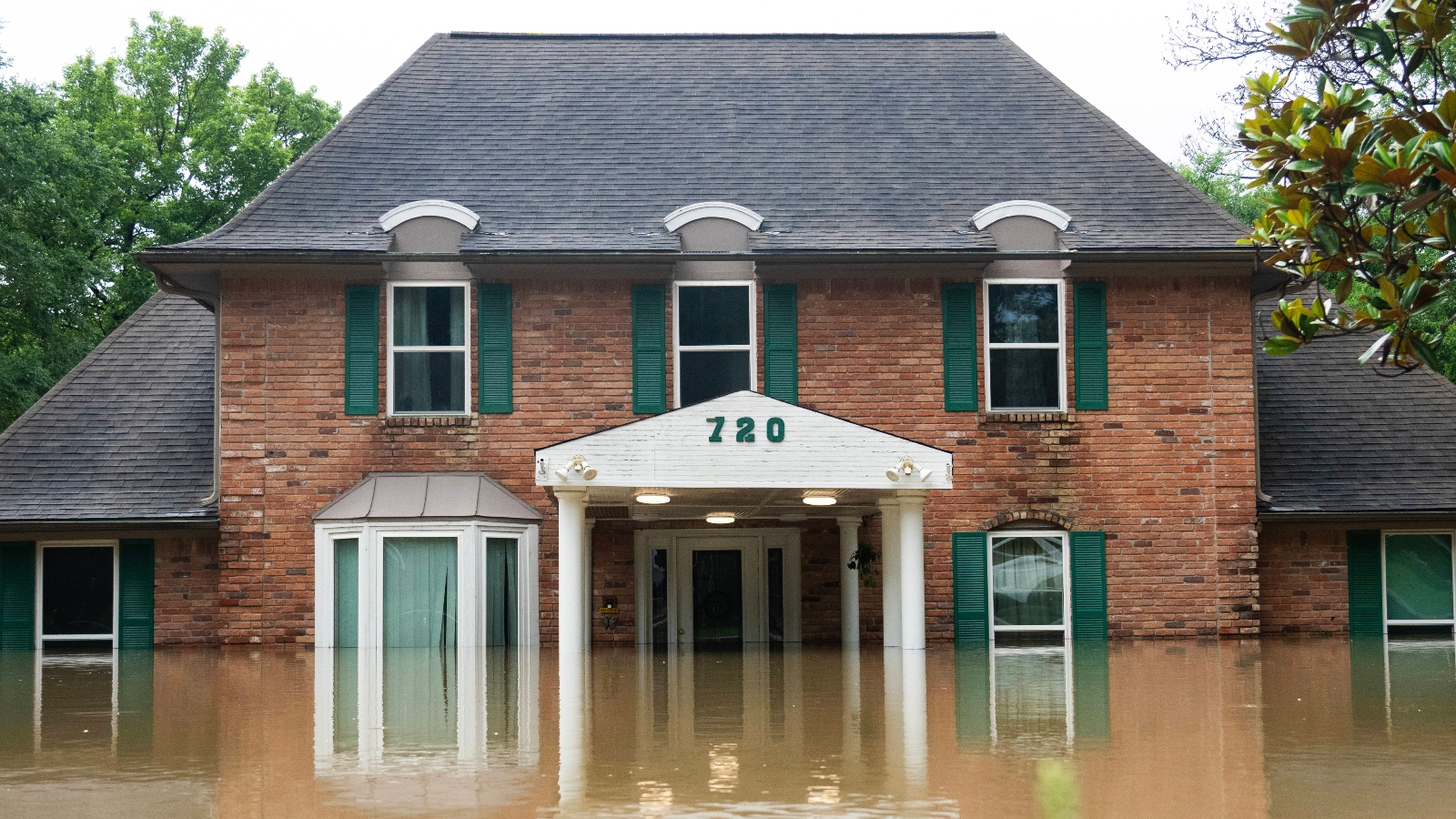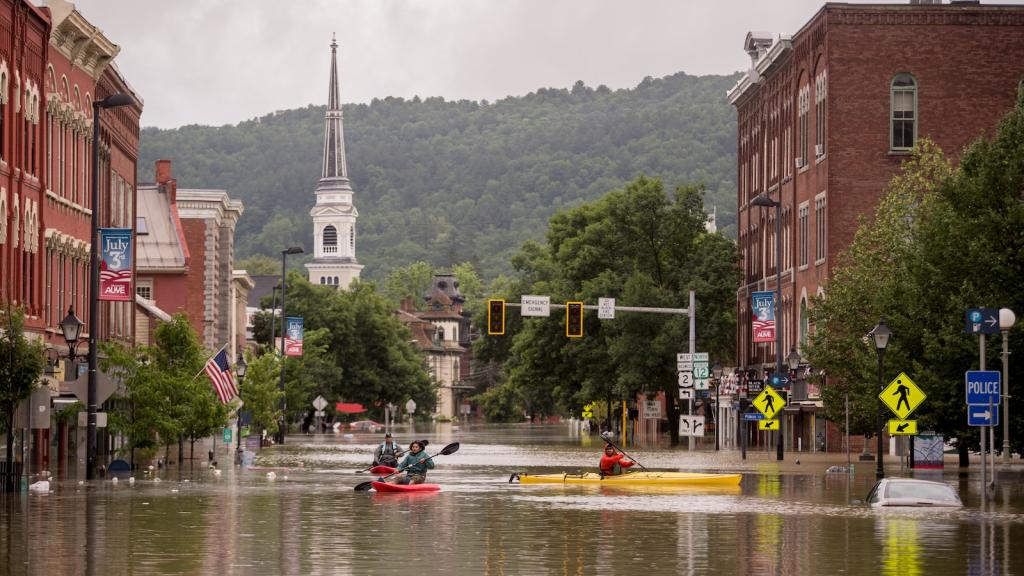As a series of monster rainstorms lashed southeast Texas last week, thousands of homes flooded in low-lying neighborhoods around Houston. The storms dropped multiple months’ worth of rainfall on Houston in the span of a few days, overtopping rivers and creeks that wind through the city and forcing officials to divert millions of gallons of water from reservoirs. Elsewhere in the state, the rain and winds killed at least three people, including a 4-year-old boy who was swept away by flooding water.
Much of the deepest flooding happened in the San Jacinto River, a serpentine waterway that winds along Houston’s eastern edge and empties into the Gulf of Mexico. This area happens to be the site of perhaps the country’s longest-running experiment in the adaptation policy known as “managed retreat,” which involves moving homeowners away from neighborhoods that will become increasingly vulnerable to disaster as climate change worsens. Harris County has spent millions of dollars buying out and demolishing at-risk homes along the river over the past decade. But the past week’s flooding has demonstrated that even this nation-leading program hasn’t been able to keep pace with escalating disaster.
“This is basically the largest and the deepest river within the county, and the floodplain is so deep that really we can’t do projects to fix these areas,” said James Wade, who leads the home buyouts for the Harris County Flood Control District. “We’re trying to get contiguous ownership in these areas so that we can basically convert it back to nature.”
It’s been slow going: Wade says the county has purchased about 600 flood-prone homes along the waterway over the past 30 years, almost all of which would have flooded during the recent storm if they hadn’t been bought out and demolished. There are still more than 1,600 vulnerable homes that the county is trying to purchase, but it has struggled to secure the necessary funds and get property owners on board.
Harris County was one of the first local governments in the United States to buy out flood-prone homes with money provided by FEMA, the federal disaster relief agency. The county has acquired more than 4,000 homes in dozens of subdivisions around Houston since the turn of the century, creating what are essentially miniature ghost towns around the city and its suburbs. Many of these neighborhoods, including the ones around San Jacinto, were so prone to flooding that the county couldn’t protect them with channels and retention ponds, which secure other residential areas.
The county doubled down on this strategy around the San Jacinto after Hurricane Harvey flooded hundreds of homes along the river in 2017, confirming that many residences were “hopelessly deep” in the floodplain, in the county’s words. Not only is the land around the river low-lying and marshy, but it also sits downstream of a reservoir that needs to release water during flood events so it does not overflow.
The county used federal funds to purchase and demolish an entire subdivision called Forest Cove, converting the open space into a “greenway” park with walking and bike trails. Elsewhere, it bought out homeowners who had already elevated their riverside homes as high as 14 feet in the air but had still seen flooding during Hurricane Harvey. These buyouts were voluntary, but after years of advocacy the county managed to persuade most homeowners to leave.
A separate county agency pursued a mandatory buyout in a few subdivisions where residents had been flooded several times, including one large community along the San Jacinto. This mandatory initiative has drawn criticism from residents who accuse the county of uprooting established communities, but the county saw it as a necessary measure to control flood risk in places where no other flood control strategies would work. More than six years after Harvey, officials are still working to close on the last of those homes.
Yet this aggressive program has still left many vulnerable neighborhoods untouched. The county gets most of its buyout funding from FEMA and the Department of Housing and Urban Development, which tend to dole out grants only after big disasters. It has also floated a $2.5 billion bond to finance flood protection and buyouts, but that sum has proven too little. There are far more flood-prone homes even along the San Jacinto than the county can afford to buy, to say nothing of the rest of the Houston metropolitan area, one of the country’s most populous urban centers.
“Money is obviously the biggest constraint,” said Alex Greer, an associate professor of emergency management at the University at Albany who has studied buyout programs. “They often have far more interested homeowners than they have funds, and the funding comes way too late.” Wade isn’t sure yet whether the flood caused enough damage to meet the criteria for a presidential disaster declaration, which would unlock significant FEMA aid and likely help the county fund more buyouts along the San Jacinto.
Furthermore, buyouts can take years to execute. In most cases, the county has to convince individual homeowners to enroll in a buyout program, then complete months of paperwork to purchase their homes, then wait for the homeowners to move. If there are holdouts who don’t want to leave, the buyouts end up happening in a “checkerboard” pattern, and the government can’t let water retake the land. Some neighborhoods, like those in the more upscale Kingwood area, are fighting for alternate solutions like new upstream reservoirs or dredging projects that could reduce flooding without homeowners needing to leave.
Even though residents along the beleaguered river have been dealing with floods for decades, Wade says he hopes this most recent flood will convince more of them to join the buyout program, allowing the county to return more land along the river back to nature. Without more money, though, he won’t be able to take advantage of what Greer calls the “window to woo.”
“Right after a flood event, that’s when people are most like, ‘I don’t want to do this again,’” he said. “But then there’s that lag of time between them coming forward and us being able to secure the funds, and they could change their minds.”



